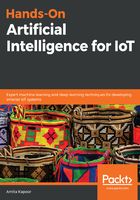
ML and IoT
ML, a subset of artificial intelligence, aims to build computer programs with an ability to automatically learn and improve from experience without being explicitly programmed. In this age of big data, with data being generated at break-neck speed, it isn't humanly possible to go through all of the data and understand it manually. According to an estimate by Cisco, a leading company in the field of IT and networking, IoT will generate 400 zettabytes of data a year by 2018. This suggests that we need to look into automatic means of understanding this enormous data, and this is where ML comes in.
Every year, Gartner, a research and advisory firm, releases a graphical representation providing a visual and conceptual presentation of the maturity of emerging technologies through five phases.
You can find the image of Gartner Hype Cycle for Emerging Technologies in the year 2018 at https://www.gartner.com/smarterwithgartner/5-trends-emerge-in-gartner-hype-cycle-for-emerging-technologies-2018/.
We can see that both IoT platforms and ML are at the Peak of Inflated Expectations. What does it mean? The Peak of Inflated Expectations is the stage in the lifetime of technology when there's over enthusiasm about the technology. A large number of vendors and startups invest in the technology present at the peak crest. A growing number of business establishments explore how the new technology may fit within their business strategies. In short, it's the time to jump in to the technology. You can hear investors joking at venture fund events that if you just include machine learning in your pitch, you can add a zero on to the end of your valuation.
So, fasten your seat belts and let's dive deeper into ML technology.